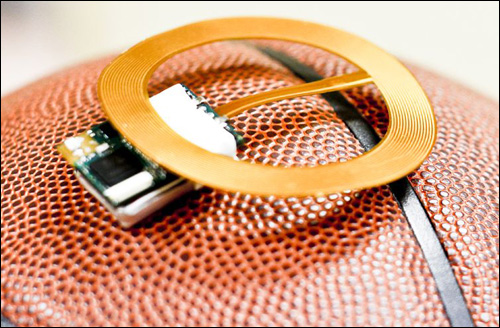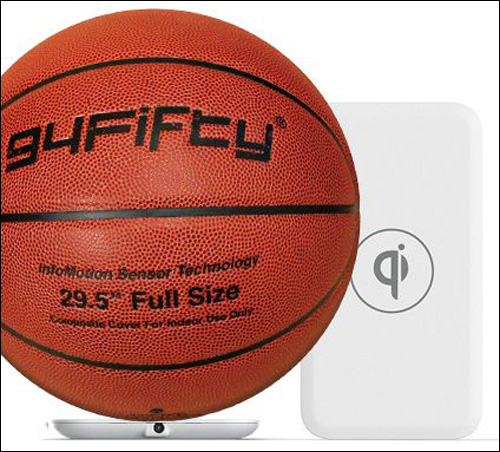InfoMotion Sports Technologies, a developer of motion sensor solutions for team sports applications, recently unveiled a new version of its 94Fifty basketball—a ball fitted with wireless sensors designed to measure an athlete’s skills in real time.
Kevin King, one of the company’s cofounders, was a Ph.D. candidate at the University of Michigan 10 years ago, when he first began investigating the use of sensors and wireless technology to enable users to gather information regarding an athlete’s performance, based on a ball’s movements. Eight years later, he and Michael Crowley, a graduate of the same university’s MBA program, cofounded InfoMotion and launched the first version of their product, which they named 94Fifty—referring to a basketball court’s length and width, in feet. That version transmits data from Wi-Fi-based sensors to a laptop. The company began selling the basketball, along with a laptop computer, to high school, college and professional teams, for approximately $2,000.

Now, in an effort to provide the solution to individual users rather than to entire teams, via a mobile phone or tablet, the company seeks funding, with plans to release a consumer version of its 94Fifty ball. Like the version designed for team players, the new ball is fitted with a small module incorporating a total of nine sensors that measure such properties as the angle and speed of a ball’s movements, as well as a chip that processes that information, a rechargeable battery and a Bluetooth transmitter to forward the relevant details to a mobile phone, tablet or other handheld running an Android or Apple operating system. The phone or tablet then uses the 94Fifty app to enable individuals to view the quality of their performance, compete or compare it with others’ performances using the same technology (either at that location or elsewhere), set up challenges, and share data with others via social networks.
According to Mark Davisson, InfoMotion Sports Technologies’ president, the company seeks $100,000 in financial support through Kickstarter, and hopes to begin taking orders for the solution soon, and to start shipping the balls with the wireless charger and app in October 2013. The balls will be available for sale online at the company Web site.
In 2003, King had begun developing sensor arrays to track balls’ movements, and started working with Crowley, a basketball player who had recommended the sport as a good target for the technology. Basketball, Davisson says, offers the repetitive nature of dribbling, as well as basket shots that require a specific speed and trajectory, and that could be measured using sensors.
The system the partners originally developed included sensors and a Wi-Fi chip to transmit all of the collected sensor data to a PC or laptop that would be running InfoMotion’s 94Fifty software. The software then processed that data, in order to provide the user with useful information about that individual’s performance, such as the angle at which the ball was thrown and the dribbling rate and speed. It also stored that data and enabled athletes to compare their results against their own previous performances, or against those of other players.
That solution, released in 2010, has several hundred customers, Davisson says, throughout the United States and internationally, in places like Dubai, Germany and Indonesia. Most users are school teams—either high schools or colleges—though the Atlanta Hawks utilize the technology for training and community outreach.

The company then began developing a version of its solution that worked in conjunction with a mobile phone. It found that processing the sensor data enabled the module installed inside the ball to then transmit a smaller packet of information via Bluetooth to a mobile phone or tablet. InfoMotion began working with Texas Instruments (TI) to develop a module incorporating one of TI’s digital signal processor (DSP) chips, a Bluetooth transceiver and a wireless charger. The entire module, measuring only a few centimeters in size, is wired to a power coil antenna, and both are attached to basketball’s lining.
The module’s nine sensors, consisting of accelerometers, gyroscopes and a magnetometer, are linked to the DSP chip, which receives as much as 6,000 unique pieces of information every second. The chip processes and filters that information, and then forwards the relevant results, via a Bluetooth connection, to a phone or tablet located up to 90 feet away.
The 94Fifty app, running the phone or tablet, enables a variety of functions, the company reports. A player can use it to follow one of 50 challenges during four different levels for shooting and ball handling (one challenge, for example, involves making a “14-foot basket off the dribble”) and track his or her history. That individual can receive coaching tips indicating the ball’s speed, arc, backspin and dribble force, as well as feedback regarding ways in which performance might be improved. Players can also share the results on social networks, such as Twitter or Facebook, and view similar results from other players around the world, or compete with them in real time, with an instant scoreboard indicating who won.
The sensor module’s built-in battery is recharged wirelessly, King says, via the coil antenna that receives power from a Qi charging pad, using technology based on the Wireless Power Consortium‘s Qi standard for inductive electrical power transfer.
The DSP chip and Bluetooth technology built into the ball can not only process and transmit sensor data, but also receive information from a mobile phone. For instance, the user’s phone app can send a firmware upgrade to the basketball at any given time, and can also deactivate the ball once play is finished, in order to conserve battery life. The ball then starts up automatically when dribbled three times. Typically, the battery has sufficient power to last for eight hours of active play before recharging is required.
The company is initially aiming the solution at individual players, but intends to release a team-based version of the application as well, that would enable a coach to store and access data about the performances of all of his or her team’s members on a single phone. The ball—available in two sizes, measuring 28.5 inches or 29.5 inches in diameter—will retail for $295, but a Kickstarter pledge of $195 or more earns the backer a free ball.
By 2014, the company also intends to release a smart soccer ball employing the same technology, to track and share soccer players’ performance data.

